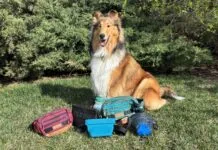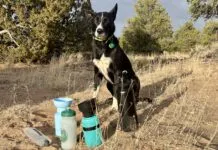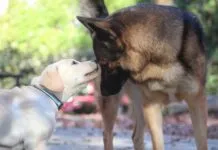What brings together heelwork, tricks, music, a little high school nostalgia, and takes it all to a whole new level? K9 drill, display, and demonstration teams are not new, but as more of us are looking for different ways to showcase the rewards of positive training to the larger dog community, the concept of drill and demo teams is gathering steam.

Photo courtesy of Karen Hilker.
288
The term “drill team” may evoke images of military marching routines (historically, military drill teams did occasionally include dogs), but today’s K9 drill and demo teams take many forms that involve dog/handler pairs. “I define it as a group of dog/handler teams, moving in unison to create a changing picture of shapes and lines, with or without music,” says Doris Herber, a retired dog trainer and behavior consultant who participated for several years in a drill team with her Basenji, Kodi.
Herber, who has had a lifelong love for dogs and a fascination with the roles dogs play in our lives, says K9 drill team has been one of her favorite activities. Herber is a pioneer in the small community of K9 drill teams, helping others learn about and participate in this activity through her articles and creating the K9 drill team Yahoo group.
While a K9 drill team is about moving together in patterns, Herber says drill work is not bound by the rules and restrictions imposed upon many dog-related activities. She describes it as very “open” and says that the process of developing routines lends itself to creativity.
The choreographed patterns of drill routines are often similar to marching band geometric formations, but they can be more akin to a square dance or line dance as well. Handlers may move through the routines with meticulous precision or with a more footloose style. Dogs move alongside their handlers heeling on the left or right side, but may also perform other movements such as pivots, turns, sits, downs, call to front, or return to heel.
These basic actions may be expanded upon with tricks such as dogs backing up, circling handlers, handlers circling dogs, leg weaves, spins – or even theatrics or a little comedy. The great thing about this activity is that it can be anything you and your teammates want it to be.
Participating in a K9 drill and demo team can benefit dogs, handlers, and even the community at large. Drill and demo teams are a great way to:
Showcase the positive. While positive training is not a requirement for a drill or demo team, the routines lend themselves to a positive approach. The demonstrations can be a wonderful way to showcase positive training techniques or bring attention to clubs and training organizations. At demos, people notice and comment on how focused the dogs are, and how even when the members make mistakes (and mistakes will be made!) the dogs look happy. “The connection that develops between handler and dog is amazing,” says Herber, and people take notice.
Build basic skills. The behaviors practiced during drill teamwork – moving together, turns, stops, stays, and more – are applicable in everyday life. Dogs learn to work near other people and dogs and to stay focused in the face of distractions. You will have the opportunity to work around crowds and in various locations. Plus, training with and being responsible to a group provides strong motivation to practice!
Be creative! Coming up with routines, finding music, and working through the kinks can be a very creative process. “The creative exchange of ideas and the problem solving is addictive,” says Herber. Playing with patterns, movements, and putting it all together is as rewarding as participating and showing off during demonstrations.
Build relationships. Working with a group demands that you spend time with your dog. “Drill team work became one of my favorite activities because it involved much one-on-one time with Kodi,” says Herber. “This one-on-one connection is one of the best benefits of the drill team activity.” Participating in a drill and demo team can be a great way to help socialize your dog and help him or her to build successful relationships with others too. The camaraderie of training and working with other like-minded people and their dogs is an added bonus.
Have fun with your dog! “Kodi seemed to enjoy the drill team work as much as I did,” says Herber. “If I started the music, he would come running from wherever he was, look me in the eye with a ‘Let’s go!’ expression.”
Forming a Team
If your interest is piqued and you think you might like to participate in a K9 drill or demo team, look around in your community or explore local dog training clubs. You may find a local drill team that you can join. But as likely as not, participating in a drill and demo team will mean starting one of your own; there just are not that many out there yet.

Photo by Laura Nicole Johnson.
288
To get a team started, look for like-minded people – those who love dog training and who want to put in the time and effort it will take to form and perform with a team. The members of the demo team I belong to are all part of a small local positive reinforcement-based training club. You may also find interested team members in training classes, or through friends or neighbors. A drill or demo team can have as few as 2 or as many as 40 dog and handler pairs, but we’ve found that 8 to 10 pairs works especially well.
Once you’ve found a few others to start a team with, set your team goals. Think about the types of routines you’d like to do. Your team may want to experiment as a group to find where your interests and abilities lie. Are you a formal team who would enjoy clean, crisp marching style routines? Or are you more inclined toward musical freestyle or tricks? Or a combination of both?
Your team will also need a place to practice. We meet at a local park, but you might also find space at a training facility or even through a community center. Figure that you will need a minimum of 40 x 60 feet of space, and for a larger group, you may need a little more.
You can start practicing, even before you have developed a routine. Practice basic skills such as:
–Attention. Your dog will need to be able to work with you and stay focused for the length of your routine.
–Heeling or walking together with pace changes, in straight lines and curved lines (perhaps on both sides).
–Transitions from sit to down to stand.
–Clean stops (usually in a standing position).
–Turns – at minimum a right, left, and about turn, but you may want to include flashier turns as well.
–Stay – especially with you walking purposefully away.
–Return to heel or dog circling the handler.
–Handler circling the dog.
These practices will build your skills for routines, and practicing in your group will also help the dogs get to know and trust each other before you work together on routines.
Expect the usual group dynamics in your drill and demo team – with the humans and dogs. For the humans, think about how you communicate with each other and make decisions, and who will lead your practices. Having some structure in place can help when it comes to group work, but plan to be flexible, too. For example, some team members will be able to learn routines in a few sessions; others may need a little more time and help from their teammates.
Consider the dogs’ group dynamics, too. Some of the dogs may immediately work well as part of the group, while others may see their canine teammates as playmates. Some dogs may be comfortable working near certain dogs, but less comfortable with others. Give the dogs time and space, and gently help them learn to trust each other. Even dogs who get along well with other dogs can be uncertain when it comes to “working” within a group of other dogs.
Developing a Routine
Developing a routine is a many step process and may be done by one or more of the team members, or the group as a whole. You might want to spend some time looking at videos of other teams and their routines for ideas.
Herber says that the most important thing to do when working on a routine is to keep it simple. You might be tempted to add in a lot of fancy tricks, but a simple routine that is well done will show better than a more complicated routine that doesn’t quite hold together. Consider using basic formations and transitions for most of the routine, and then pick just one or two flashier moments as focal points.

288
The formations are really the main structure of a routine. They are basically the geometric shapes (like a circle, rectangle, triangle, or diamond) that your team members create. The formations can be made up of single or double lines, crossed lines, arrows, or curved lines. When your team is in a formation, you can move together as a unit, keeping the shape, for example walking in a circle. Or you can remain stationary while having the dogs perform a behavior such as circling the handler or while having the handler perform a behavior such as circling the dogs.
The transitions are what you do to get from one formation to another. These are essential to the flow of the routine. Imagine your team is in a circle formation facing the center, and you want to move into a straight line with everyone facing the audience. You could move by “following the leader” around the circle and into a line, or with half of the team moving in one direction and half in the opposite direction, meeting in the middle. How you put this all together is part of the creative challenge and fun.
When planning a routine, be aware of the skill set and abilities of your handlers and dogs. If your group has varied levels of experience, you will need to consider what all of the team members can reasonably accomplish. Herber says, “We had two greyhounds on our first team. They could not sit well.” They decided to have the greyhounds at each end of the line in a standing position while the other dogs sat. The dogs’ limitations became a design decision!
Build in some flexibility to your routines too. You might end up performing a routine in a smaller space than you expected, or you may have a team member not be able to make a performance because of an illness. “Once we got to a location to perform for a Boy Scout troop and found a large support pole in the middle of the space,” says Herber. “We had to quickly alter our routine to accommodate the pole.”
Your group will also need to decide if you want to use music. Music is not essential, but it can give you a rhythm to work with and it can add polish to a performance. When you choose music, know that it will be something that you will listen to a lot while practicing! Choose something that you and your teammates will enjoy, but that will also be a crowd pleaser. Pick something with a good beat and look for the right tempo for your group. Consider copyright issues too. If you are doing small performances and you are not charging money, you will not likely have an issue, but it’s something to keep in mind.
Once you have thought about the types of patterns, transitions, and movements you’d like to include and you’ve chosen your music, you’re ready to start putting your moves to the music. It can help to listen to the music and walk through different moves to make sure they work together (this might be best done without the dogs!). You may want to diagram your routine (think football diagrams) to help you visualize. Once you get an idea of what you want to do, try it out and adjust as needed.
Practice, Practice . . .
For a polished routine, you will need more practice than you might imagine. You (the human partners) will need to learn your part – where you need to be and when; it’s very much like learning a series of dance steps. Then you’ll need to learn to do it in coordination with your teammates. Spacing, timing, and straight lines will make all the difference in how your routine looks to an audience. It is a great idea to practice this without your dogs first; your learning mistakes could cause confusion for your dogs.
While you’re learning your part, practice individual elements with the dogs, such as moving together in a straight line or a circle. Even a simple routine can be much harder for the dogs than it may seem, so laying a good foundation can really help keep it fun for them.
Once you and the dogs have got your parts down, and your team is working well together, take your practice to new locations. Don’t be surprised if your dogs work differently on grass than they do on pavement, and moving from outdoors to indoors can be a whole new experience. All of you may have a harder time when there is another activity going on right next to where you are practicing or performing, too. At a recent performance, the announcer in the ring next to ours was so loud, that we (the people) had a really hard time with our timing and cuing off of the music. In addition, dogs running lure coursing across the field from our ring gave our dogs an extra distraction. You never know what challenges you might run into, so practicing around all kinds of distractions will help.
The Show on the Road
When you and your teammates are comfortable with your routine, look for places to perform. “Our nameless K9 drill team did performances for training classes, nursing homes, school groups, Boy Scouts, and anyone who would watch,” says Herber. Local dog events, shelter fundraisers, and other community activities are also good venues.
For some members, the performance will be the highlight. It can be fun to show off your dog and entertain a crowd. For others, the actual performance might be a little nerve-wracking. But the payoff at the end can be worth it.
“When everything falls into place and someone comes up to you afterward and says, ‘You gave me goose-bumps and brought tears to my eyes,’ it makes it all worthwhile,” says Herber.
Mardi Richmond is a writer, trainer and a member of the Santa Cruz Dog Training Club’s un-named heelwork and drill demo team. Being part of the demo team is by far her dog Chance’s favorite activity!








